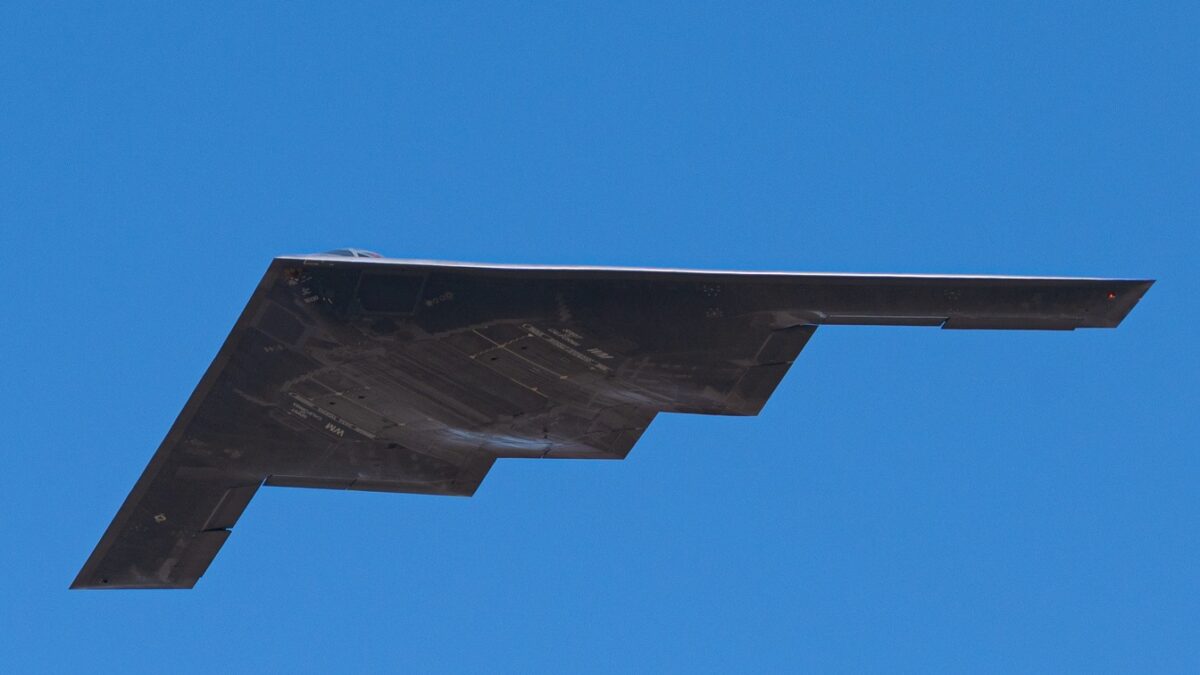B-21: The Last Stealth Bomber? We in the defense industry take stealth technology on airplanes for granted. U.S. arms builders have been working on radar-evading coatings and designs since the 1980s, and American adversaries such as Russia and China have developed their own next-generation stealth airplanes to keep up with the trend.
Stealth attributes for aircraft are expensive. Pulling them off correctly requires the best efforts of the most adept designers, scientists, and engineers. Some airplanes are stealthier than others – much depends on the shape of the airplane and the efficacy of stealth coatings.
The Last Stealth Bomber?
The new B-21 Raider will be showcased to the public for the first time on Dec. 2. The bomber is advertised as extremely stealthy – maybe even a better radar evader than the F-35 and F-22. The idea is to have a bomber sneak past air defense networks and penetrate as far as necessary to deliver nuclear and conventional bombs and missiles. The B-21 must have the ability to do all that and still fly safely back to base in the United States.
But could this be the last stealth bomber the United States ever builds? The Air Force hasn’t produced a new bomber in 34 years when the B-2 Spirit was introduced in 1988. The B-21 is meant to replace the B-1 and the B-2, while the latest B-52 upgrades are designed to keep the Stratofortress in service for decades.
The B-21 is reportedly on time and under budget, and if it stays that way, the Air Force could order between 100 and 200 of the next-generation strategic bombers. The United States currently operates less than 125 bombers, and they are becoming more expensive to maintain and keep in the air. The B-21 is thus coming in at the right time. It may make its first flight in 2023.
While there are few if any estimates of how long the new B-21 could be in service, let’s say the bomber stays in use until the 2050s. After all, the B-52 is not a stealth aircraft, and it has flown in all of America’s major wars since Vietnam. The B-21, then, could indeed be the last stealth bomber built.
One reason for this is the U.S. need to modernize its nuclear triad with upgraded intercontinental ballistic missiles and submarines.
There may simply not be enough money to develop another stealth bomber. The Air Force and the Navy are working on the Next-Generation Air Dominance fighter, which could cost into the hundreds of millions of dollars for each unit. Resources for airplanes could become tight in the coming years.
China and Russia Want to Keep Up
The other question is how well Russia and China develop nuclear-capable stealth bombers of their own. This then becomes a strategic decision concerning the ability of the United States to maintain nuclear deterrence. Russia is bound by the New START nuclear arms treaty, but China is not. The Chinese could build as many new bombers as possible while advancing its new radar systems, which China claims are anti-stealth.
The B-21 is not only needed as soon as possible, but it may have to serve until 2050 or later. U.S. defense contractors are likely to make incremental improvements on stealth coatings to enhance the radar-evasion characteristics of the B-21 without having to design a new airplane.

Artist image of B-2 Spirit. The B-21 Raider will look similar.
Another way to improve stealthiness of the B-21 is to keep a stealth tanker drone in the works. This would keep the Chinese or Russian from detecting a non-stealthy tanker during aerial refueling – an operation that is required for the B-21 to have maximum efficacy in the Indo-Pacific.
B-21 Must Be a Success
There is much riding on the success of the B-21 program. The Air Force needs new bombers. China and Russia are working on their own. The airframe must be long-lasting and durable enough to serve for decades, as this could be the last stealth bomber the United States ever builds. If the B-21 flies next year and more come off the production lines, the Air Force should enjoy strategic deterrence with an upgraded leg of its nuclear triad put into force, not to mention conventional bombing and missile capability.
It appears the U.S. military will depend on the B-21 to live a long and distinguished life.
B-21 and B-2 Photos

Artist image of B-2 Spirit. The B-21 Raider will look similar.

Northrop Grumman

Image of B-2 Spirit stealth bomber. Image Credit: Creative Commons.

B-2 Spirit. Image Credit: Northrop Grumman.

Artist rendering of a B-21 Raider concept in a hangar at Dyess, Air Force Base, Texas, one of the future bases to host the new airframe. (Courtesy photo by Northrop Grumman)

A B-2 Spirit stealth bomber from Whiteman Air Force Base completes a fly-over during the Sound of Speed Airshow at Rosecrans Air National Guard Base, in St. Joseph, Missouri, May 1, 2021. The air show was hosted by the city of St. Joseph and 139th Airlift Wing, Missouri Air National Guard to thank the community for their support. (U.S. Air National Guard photo by Airman Janae Masoner)
Expert Biography: Serving as 1945’s Defense and National Security Editor, Dr. Brent M. Eastwood is the author of Humans, Machines, and Data: Future Trends in Warfare. He is an Emerging Threats expert and former U.S. Army Infantry officer. You can follow him on Twitter @BMEastwood. He holds a Ph.D. in Political Science and Foreign Policy/ International Relations.

